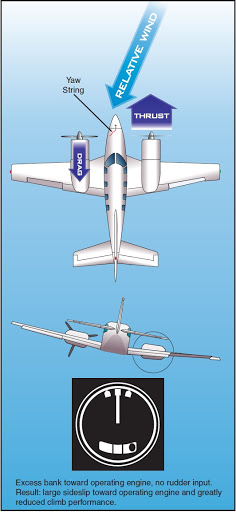# ONE ENGINE INOPERATIVE:
Table of Contents:
- What Is One Engine Inoperative?
- One Engine Inoperative Flight Principles
- Counteracting The Asymmetrical Thrust At One Engine Inoperative Condition
- One Engine Inoperative – Asymmetrical Yaw
What Is One Engine Inoperative?
One engine inoperative is a condition where one of the engines on a multi-engine aircraft fails and as a result, a thrust imbalance exists between the operative and inoperative sides of the aircraft. This thrust imbalance (asymmetrical thrust) causes several negative effects in addition to the loss of one engine’s thrust.

One Engine Inoperative Flight Principles:
After the flaps and landing gear have been retracted and the propeller of the failed engine feathered, a key element in best climb performance is minimizing sideslip. With a single-engine aircraft or a multi-engine aircraft with both engines operative, sideslip is eliminated when the ball of the turn and bank instrument is centered. This is a condition of zero sideslip, and the aircraft is presenting its smallest possible profile to the relative wind.
As a result, drag is at its minimum. Pilots know this as coordinated flight. In a multiengine airplane with an inoperative engine, the centered ball is no longer the indicator of zero sideslip due to asymmetrical thrust. In fact, there is no instrument at all that directly tells the pilot the flight conditions for zero sideslip. In the absence of a yaw string, minimizing sideslip is a matter of placing the airplane at a predetermined bank angle and ball position. The AFM/POH performance charts for single-engine flight were determined at zero sideslip. If this performance is even to be approximated, the zero sideslip technique must be utilized.
Counteracting The Asymmetrical Thrust At One Engine Inoperative Condition:
There are two different control inputs that can be used to counteract the asymmetrical thrust of a failed engine:
- Yaw from the rudder.
- The horizontal component of lift that results from bank with the ailerons.
Used individually, neither is correct. Used together in the proper combination, zero sideslip and best climb performance are achieved.
One Engine Inoperative – Asymmetrical Yaw:
When one engine fails, a yawing moment develops, which applies a rotational force to the aircraft that tends to turn it toward the wing that carries the engine that failed. A rolling moment might develop, due to the asymmetry of the lift in each wing, with a greater lift generated by the wing with the operating engine. The yawing and rolling moments apply rotational forces that tend to yaw and roll the aircraft towards the failed engine. This tendency is counteracted by the pilot’s use of the flight controls, which include the rudder and ailerons.
Due to P-factor, a clockwise rotating right-hand propeller on the right wing typically develops its resultant thrust vector at a greater lateral distance from the aircraft’s center of gravity than the clockwise rotating left-hand propeller. The failure of the left-hand engine will result in a larger yawing moment by the operating right-hand engine, rather than vice versa. Since the operating right-hand engine produces a larger yawing moment, the pilot will need to use larger deflections of the flight controls or a higher speed in order to maintain control of the aircraft.
Thus, the failure of the left-hand engine has a greater impact than failure of the right-hand engine, and the left-hand engine is called the critical engine. On aircraft with propellers that rotate counter-clockwise, such as the de Havilland Dove, the right engine would be the critical engine.

Most aircraft that have counter-rotating propellers do not have a critical engine defined by the above mechanism, because the two propellers are made to rotate inward from the top of the arc; both engines are critical. Some aircraft, such as the Lockheed P-38 Lightning, purposefully have propellers that rotate outward from the top of the arc, to reduce downward air turbulence, known as downwash, on the central horizontal stabilizer, which makes it easier to fire guns from the aircraft. These engines are both critical, but more critical than inward-rotating propellers.
Aircraft with propellers in a push-pull configuration, such as the Cessna 337, may have a critical engine, if failure of one engine has a greater negative effect on aircraft control or climb performance than failure of the other engine. The failure of a critical engine in an aircraft with propellers in a push-pull configuration typically will not generate large yawing or rolling moments.
